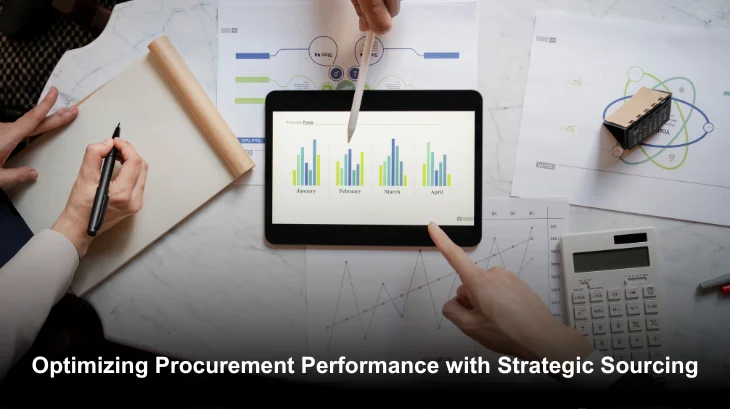
Have any questions Submit an Inquiry

In the dynamic realm of procurement, organizations strive to not only meet their immediate needs but also to establish sustainable and cost-effective supply chains. At EmpoweringCPO, we excel in Strategic Sourcing Outsourcing, a methodical approach to procurement that emphasizes data-driven decision-making, market intelligence, and innovative procurement analytics tools. This blog post aims to guide organizations through the essential tips and tricks for mastering the art of Strategic Sourcing services, exploring key elements such as procurement services, analytics tools, and spend data analysis, along with additional insights to enhance the strategic sourcing journey.
Strategic Sourcing is a multifaceted strategy that extends beyond cost reduction, focusing on building resilient supply chains and optimizing long-term competitiveness. It integrates market intelligence, data analytics, and robust supplier relationships. By adopting this approach, organizations can strategically manage their procurement processes to achieve significant cost savings and operational efficiency.
Data-Driven Decision-Making: The foundation of successful Strategic Sourcing lies in data. Advanced analytics tools empower organizations to extract meaningful insights, facilitating informed decision-making. By harnessing the power of data, procurement teams can identify opportunities for cost optimization, negotiate favorable contracts, and proactively manage risks.
In a rapidly evolving business landscape, staying ahead requires continuous monitoring of market dynamics. Organizations must invest in robust market intelligence systems to stay informed about supplier capabilities, industry trends, and potential risks. This knowledge enables proactive decision-making, helping organizations adapt swiftly to changes in the market.
Beyond basic analysis, conducting a thorough spend data analysis is crucial. By categorizing and scrutinizing procurement spend, organizations can identify patterns, outliers, and potential areas for improvement. This detailed analysis facilitates better decision-making, allowing procurement teams to prioritize their efforts effectively.
Establishing and nurturing strong relationships with suppliers is a cornerstone of success. Engaging with strategic sourcing consulting firms can aid in developing effective Supplier Relationship Management (SRM) programs. These programs focus on collaboration, communication, and continuous improvement, fostering a partnership that goes beyond transactional interactions.
Leverage external expertise by considering outsourcing. Collaborating with experts in the field allows organizations to tap into specialized knowledge, gain access to cutting-edge technologies, and achieve cost efficiencies. Outsourcing certain aspects of the process can enhance overall procurement capabilities.
Anticipating and mitigating risks is a crucial aspect. Organizations should proactively identify potential risks in the supply chain and implement strategies to mitigate them. This could involve diversifying the supplier base, developing contingency plans, or utilizing technology to monitor and manage risks effectively.
Strategic Sourcing is an ongoing process that requires continuous improvement. Regularly reassessing strategies, exploring innovative technologies, and adapting to evolving market conditions is essential. Embrace a culture of continuous improvement to ensure that your organization remains agile and responsive in the face of change.
Define and track key performance indicators (KPIs) to measure the success of your initiatives. Metrics such as cost savings, supplier performance, and cycle times provide valuable insights into the effectiveness of your strategies. Regularly review and analyze these metrics to refine and optimize your procurement processes.
Technology Integration: Embrace technology as a key enabler in the journey. Implementing advanced procurement tools, such as e-sourcing platforms and AI-driven Procurement analytics Tools, can significantly enhance efficiency and accuracy. Automation of routine tasks allows procurement professionals to focus on strategic activities, driving better outcomes.
Cross-Functional Collaboration: Foster collaboration across various organizational functions. This approach extends beyond the procurement department, involving stakeholders from finance, operations, and other relevant areas. Cross-functional collaboration ensures alignment with broader business goals and enhances the effectiveness of initiatives.
Incorporate sustainable practices into your initiatives. Consider the environmental and social impacts of your supply chain decisions. This not only aligns with corporate responsibility goals but can also lead to cost savings through resource efficiency and reputation enhancement.
Explore opportunities in global sourcing to diversify your supplier base and tap into cost-effective markets through Procurement Market intelligence. Assess geopolitical risks, transportation costs, and regulatory considerations to create a comprehensive global sourcing strategy that aligns with your organization’s objectives.
Invest in talent development within your procurement team. Building a skilled and knowledgeable workforce is essential for effective strategies. Training programs, certifications, and continuous learning initiatives can enhance the capabilities of your procurement professionals.
Incorporate scenario planning into your strategy. Anticipate potential disruptions and develop contingency plans to ensure resilience in the face of unforeseen events. This proactive approach enables organizations to navigate uncertainties and maintain operational continuity.

Mastering the art of this approach demands a holistic and proactive approach, encompassing data-driven decision-making, market intelligence, strong supplier relationships, and a commitment to continuous improvement. At EmpoweringCPO, our comprehensive strategic sourcing services are designed to guide organizations in optimizing their procurement performance. By incorporating these essential tips and tricks, along with additional insights, businesses can navigate the complexities of the procurement landscape, achieve sustainable cost savings, and position themselves for long-term success in a competitive market.
EmpoweringCPO is a team of experienced sourcing and procurement professionals with hands on experience of having worked with many fortune 500 companies. The company was founded in 2011 and since then has executed multiple strategic sourcing projects and have achieved average savings of 10-12% so far. In addition to Strategic Sourcing their other offerings are Spend Analysis, Procurement Intelligence, Procurement Analytics, Best Cost Country Sourcing, Procurement Outsourcing, Built Operate Transfer, Supplier Diversity, Sustainable Procurement, Tail Spend Management, Item Master Optimization, Collective Buying, Compliance Tracking and Managed Procurement Services.
Get A Call Back
Compliance management is very critical as otherwise the procurement organization may run into a scenario where there is a huge gap between realized savings and reported savings. Many procurement functions estimate large savings numbers when contracts are signed. They also invest significant time and effort in negotiating contracts for necessary goods and services, only to have a third or more of their purchasing dollars flow outside those deals. Some of the obvious fall-outs of non-compliance and maverick purchases are:
As compared to the current contract that was finalized after the sourcing process, the tool helps in tracking:
The objective of this tool is to ensure that the orders are placed only with the vendors that were shortlisted after the sourcing process and at the same price that was agreed upon and negotiated during and after the strategic sourcing process.